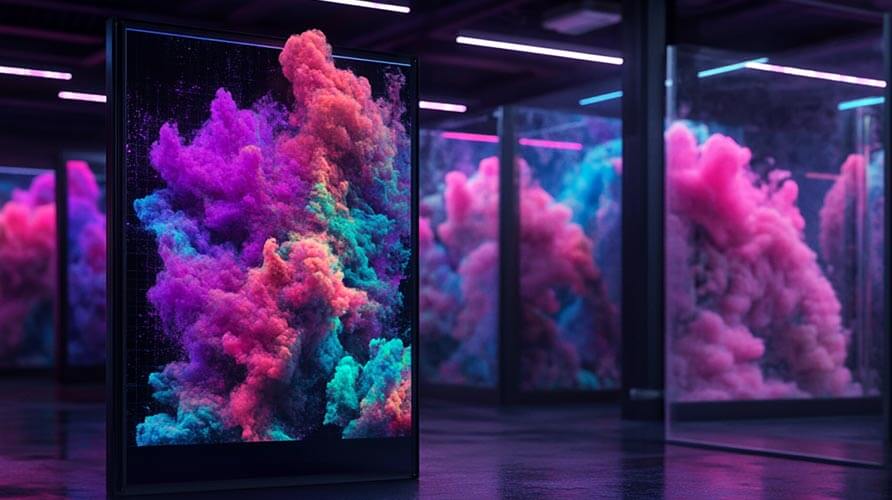The Future of AI in Color Generation

Artificial intelligence has been transforming numerous industries, and design is no exception. One of the most exciting developments in this field is the application of AI to color generation and palette creation. This technology is not only making designers' lives easier but also opening up new creative possibilities that were previously unimaginable.
How AI is Revolutionizing Color Palette Generation
Traditional color palette creation often involves a deep understanding of color theory, extensive experience, and sometimes a bit of intuition. While these skills remain valuable, AI is now providing tools that can accelerate and enhance this process in several ways:
Harmony-Based Palette
Mood-Based Palette
1. Analyzing Vast Datasets of Color Combinations
AI systems can analyze millions of existing designs, artworks, photographs, and other visual content to identify successful color combinations. By learning from this vast dataset, AI can suggest palettes that have proven effective in similar contexts or for specific emotions.
The Power of Context-Aware Color
As you scroll through this section, notice how the background color shifts subtly, demonstrating how AI can create dynamic color experiences that respond to user interaction and context.
This technology enables designers to create more engaging and emotionally resonant experiences by adapting colors to user behavior, content, or environmental factors.
2. Understanding Context and Purpose
Modern AI color tools don't just generate random harmonious colors; they can understand the context and purpose of a design. Whether you're creating a website for a financial institution or packaging for an organic food product, AI can suggest appropriate color schemes that align with industry expectations and brand values.
3. Accessibility Considerations
AI can automatically evaluate color combinations for accessibility concerns, ensuring sufficient contrast for readability and considering various forms of color vision deficiency. This helps designers create inclusive designs without having to manually check every color combination.
4. Real-time Adaptation
Some AI color systems can adapt in real-time to user preferences and feedback, learning what works for specific designers or projects and refining suggestions accordingly.
Current AI Color Generation Technologies
Neural Networks for Color Harmony
Deep learning models trained on color theory principles and existing designs can generate harmonious color combinations that follow established rules while still feeling fresh and innovative.
GANs (Generative Adversarial Networks)
These AI systems consist of two neural networks that work against each other - one generating color palettes and the other evaluating them. This competitive process results in increasingly sophisticated and aesthetically pleasing color combinations.
Computer Vision for Color Extraction
AI can analyze images to extract dominant colors and create palettes based on existing visuals. This is particularly useful for maintaining consistency with photography or creating designs that complement specific imagery.
The Future of AI Color Generation
As we look toward the future, several exciting developments are on the horizon:

Emotion-Responsive Color Systems
Future AI may generate color palettes that respond to emotional inputs or biometric data, creating truly personalized color experiences.

Cultural and Regional Adaptation
More sophisticated AI will better understand cultural differences in color perception for global audience adaptation.

Dynamic Color Systems
AI may generate complete color systems that adapt to different contexts while maintaining brand consistency.
Collaborative AI Color Tools
Future tools will likely offer more collaborative features, where AI and human designers work together iteratively, with the AI learning from the designer's choices and providing increasingly relevant suggestions.
Ethical Considerations
As with any AI technology, there are important ethical considerations:
- Originality and creativity: Will reliance on AI-generated color palettes lead to homogenization of design?
- Transparency: Users should understand how AI recommendations are generated and what data they're based on.
- Bias: AI systems may perpetuate existing biases in design if not carefully developed and monitored.
- Human expertise: The role of human judgment and creativity remains essential, with AI serving as a tool rather than a replacement.
Conclusion
The future of AI in color generation is bright and colorful. As these technologies continue to evolve, they will provide designers with increasingly powerful tools to create harmonious, effective, and innovative color schemes. Rather than replacing human creativity, AI will amplify it, handling technical aspects of color selection while allowing designers to focus on the bigger picture of communication and emotional impact.
For designers looking to stay ahead of the curve, embracing these AI color tools while maintaining a strong foundation in color theory principles will be the winning combination. The most successful designers of tomorrow will be those who can effectively collaborate with AI, guiding its suggestions with human insight and creative vision.
